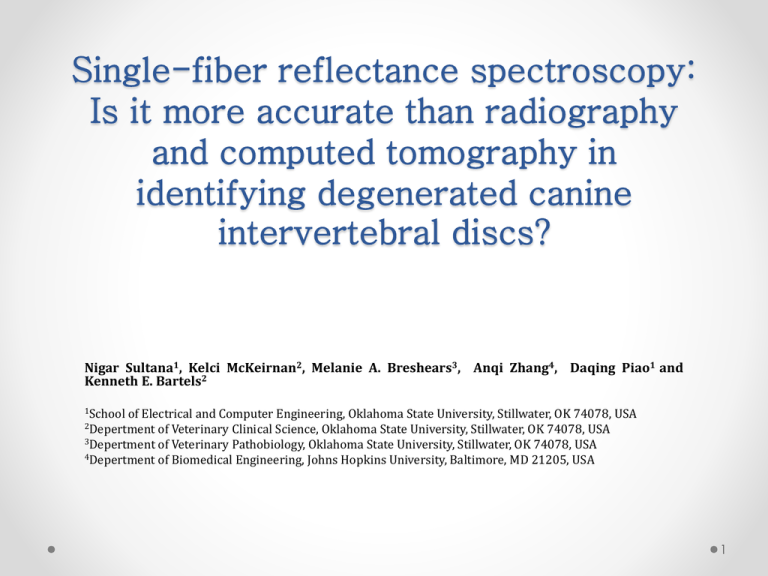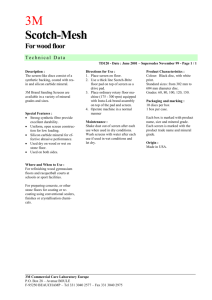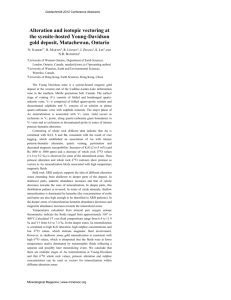Single-fiber reflectance spectroscopy: Is it more accurate than
advertisement

Single-fiber reflectance spectroscopy: Is it more accurate than radiography and computed tomography in identifying degenerated canine intervertebral discs? Nigar Sultana1, Kelci McKeirnan2, Melanie A. Breshears3, Anqi Zhang4, Daqing Piao1 and Kenneth E. Bartels2 1School of Electrical and Computer Engineering, Oklahoma State University, Stillwater, OK 74078, USA of Veterinary Clinical Science, Oklahoma State University, Stillwater, OK 74078, USA 3Depertment of Veterinary Pathobiology, Oklahoma State University, Stillwater, OK 74078, USA 4Depertment of Biomedical Engineering, Johns Hopkins University, Baltimore, MD 21205, USA 2Depertment 1 OVERVIEW Background Motivation and Objective System configuration Imaging protocols Results Summery 2 Background Intervertebral discs (IVD), located between the vertebrae in the spine and act as “shock absorbing cushions” which allows slight movement of vertebrae Intervertebral discs are comprised of two layers o Annulus fibrosus ---Tough outer fibrous lamellar layer o Nucleus pulposus --- Gelatinous inner core Source: http://www.spineuniverse.com/conditions/herniated-disc 3 Background Intervertebral disc herniation is a common disease that affects the vertebra The chondrodystrophoic dogs (dachshund, Pekingese, etc.) mainly seem to have disc degeneration along the entire vertebral column while it is even common in humans also Loss of nucleus fluid and deposition of a calcified mineral component within the nucleus makes the disc degenerated Degenerated disc is less resilient to normal wear and tear Degeneration can cause severe pain, nerve compression and paralysis Extrusion of degenerated disc material through the dorsal annulus Source: http://www.mayfieldclinic.com/PEHLDisc.htm#.Ujy34sakquM 4 Background Treatment Surgical disc fenestration--- most widely used treatment for intervertebral disc disease It’s a highly invasive procedure Very complex Recurrence rate as high as 19.2 % as reported by several large scale studies of a mixed population of dogs Source: http://cal.vet.upenn.edu/projects/saortho/chapter_62/62mast.htm 5 Background Percutaneous Laser disc Ablation (PLDA)--minimal invasive procedure for intervention of intervertebral disc disease This laser surgical treatment photothermally ablates the disc material and fibrotic scar tissue forms which presumably prevents the disc from herniating in the future PLDA is performed by passing an optical fiber through a needle placed percutaneously in the center of a disc to introduce laser energy, most frequently from a 2100 nm holmium:YAG (Ho:YAG) laser PLDA shown to have minimum recurrence rate as low as 3.4 % 6 Motivation In current practice, PLDA is performed in thoracolumbar IVD with same laser fluence applied to each disc, regardless of its mineral content Knowledge of individual disc mineral composition would allow treatment of degenerated discs that otherwise may have been missed Mineralized volume quantization of individual disc would permit laser energy dosage adjustments for specific degenerated disc 7 Motivation (Imaging) Current standard for diagnostic imaging for canine IVD degeneration is X-ray radiography, which usually shows as opacification of the disc space Radiography is also used to guide the needle positioning into the center of each treated disc for PLDA However, radiography is not adequately sensitive in identifying the degenerated discs, nor is it reliable for characterizing the degree of disc degeneration When compared with histopathology, radiography has a sensitivity of 30 % and specificity of 100 % in diagnosing disc degeneration Source: http://www.vetsurgerycentral.com/myelogram.htm 8 Motivation (imaging) X-ray computed tomography (CT) and magnetic resonance imaging (MRI) usually able to pinpoint the precise location of degenerated disc However, it is not also highly sensitive in characterizing the degree of disc degeneration and sometimes provide misleading results in identifying the degenerated discs When compared with histopathology, computed tomography (CT) has a sensitivity of 75% and specificity of 60 % in diagnosing disc degeneration Moreover, due to the cost and inconvenience it is challenging to standardize PLDA surgery under CT or MRI image guidance Source: http://www.mayfieldclinic.com/PE-HLDisc.htm#.Ujy7jsakquM http://canadawestvets.com/disc-disease 9 Motivation (Optical) An imaging/sensing technology that provides a more accurate preoperative in-situ assessment of the disc mineralization, and potentially rapid post-operative feedback, could optimize the outcome of the PLDA procedure Single-fiber reflectance spectroscopy---o Sense the changes of tissue compositions in the disc o A diagnosis modality that could be integrated to PLDA procedure http://www.dfwvetsurgeons.com/downloads/Newsflash_rdvm.pdf 10 Hypothesis (scattering) The hypotheses o The mineral deposit within degenerated IVD increases scattering o IVD that contains mineral works as an avascular medium o The more degenerated disc is, the more scattering the medium should become 11 Objective The objective of this study is to revaluate whether the needlebased single-fiber reflectance spectroscopy could have higher accuracy in identifying degenerated intervertebral discs compared to X-ray radiography and computed tomography (CT) If needle-based single-fiber reflectance spectroscopy could provide a positive correlation with histopathology results If SfRS could have a higher sensitivity in grading degree of disc degeneration 12 System configuration The experimental setup includes: Computer Light Source Spectrometer Halogen -Deuterium Source Spectrometer Bifurcated fiber bundle 320μm single fiber with 15° Bifurcated fiber bundle single fiber 150 angle polished fiber in needle angle polished tip Computer 20 gauge needle 15° Schematic of Single fiber reflectance spectroscopy setup 13 Analytical Representation 4 5 x 10 4.5 4 Raw Spectrum Intensity (a.u.) 3.5 R Norm (λ) = 3 2.5 R tissue λ − R water (λ) R air λ − R water (λ) 2 1.5 1 0.5 0 550 600 650 700 750 800 wavelength (nm) 850 900 950 1000 8 7.5 Normalized intensity absorption coefficient 7 R Norm (𝑑𝑓 ) = 𝑅0 Norm (𝑑𝑓 ) 𝑒 −μ𝑎,𝑡𝑖𝑠𝑠𝑢𝑒 ⟨L⟩ Normalized Intensity 6.5 6 Normalized Spectrum 5.5 5 Incident light intensity photon path length 4.5 4 3.5 3 550 600 650 700 750 800 wavelength (nm) 850 900 950 14 Imaging protocol 15 Imaging protocol Acquisition time: 2 second/measurement -Step1: Measurements -Step2: PLDA procedure -Step3: Measurements extending ~1mm Reflectance spectroscopy 16 Results (Dog#1 Radiography and CT) L2-3, slight nuclear mineralization L4-5, no nuclear mineralization No mineral present on radiographs 17 Results (Dog#2 Radiography and CT) T10-11 mineralized T11-12 mineralized T12-13 mineralized L1-2 mineralized L2-3 mineralized L3-4 mineralized L4-5 mineralized L5-6 mineralized T8-9 T12-12 L2-3 L3-4 L4-5 are mineralized in radiograph L7-S1 Results (Dog#3 Radiography and CT) T10-11 mineralized T11-12 mineralized T12-13 mineralized T13-L1 mineralized L1-2 mineralized L2-3 mineralized L3-4 mineralized L4-5 mineralized T10-11 mineralized 19 Results (Radiography and CT) Radiographic and CT imaging were performed on all thoracic and lumbar intervertebral discs of the two cadaveric dogs The needles for Single fiber reflectance spectroscopy sensing and subsequently for PLDA were placed successfully in “ Dog 1” from T8– 9 to L5– 6 and in “ Dog 2 and Dog 3” from T9– 10 to L5– 6. Therefore only the radiography and CT images of those discs being evaluated by Single fiber reflectance spectroscopy measurement are displayed 20 Results (Dog1) disc No Radiograph CT T8-9 No mineralization No mineralization T10-11 No mineralization Slight focal mineral in nucleus T11-12 No mineralization T12-13 No mineralization No mineralization None No mineralization Pathology 2 small foci of light mineralization within nucleus (<10%) with equivocal mineralization at periphery of presumptive char tract No mineralization Large central focus of dense mineralization (60%) in nucleus No mineralization 2 distinct foci of mineralization/bone within nucleus that composed approx. 35% of visible nucleus T13-L1 No mineralization L1-2 No mineralization No mineralization No mineralization L2-3 No mineralization very focal mineral (nucleus) Focus of dense mineralization near center of nucleus (in chondroid tissue) (30%) L3-4 No mineralization No mineralization No mineralization L4-5 No mineralization No mineralization No mineralization L5-6 No mineralization No mineralization equivocal mineralization at edge of nuclear material surrounding described focus of cavitation (10%) 21 Results (Dog2) disc No Radiograph CT Pathology T10-11 No mineralization rim mineralization of nucleus no mineralization on H&E T11-12 No mineralization rim mineralization of nucleus 2 small foci of mineralization in nucleus material (~5% of nucleus) many foci of distinct mineralization (approximately 60% of nucleus material) admixed with granular debris interpreted to represent mineralized tissue T12-13 small amount of mineral T13-L1 No mineralization L1-2 No mineralization small amount of mineral no distinct mineralization in nucleus L2-3 small amount of mineral small amount of mineral 2 small and equivocal foci of mineralization in nucleus (approximately 10% of nucleus) L3-4 small amount of mineral small amount of mineral multiple mineralized foci comprise approximately 40% of the nucleus L4-5 small amount of mineral small amount of mineral basophilic coagulum interpreted to be charred mineralized material composes approximately 70% of nucleus L5-6 No mineralization small amount of mineral mineralized tissue composes approximately 50% of nucleus tissue present in section heavily mineralized No mineralization no distinct mineralization in visible nucleus 22 Results (Dog3) disc No Radiograph CT Pathology T10-11 mineralized large amount of mineral nearly all of the nucleus material on slide is VK+ (mineralized) T11-12 no mineralization moderate mineral central nucleus 4 fairly large foci of mineralization in nucleus (approximately 40% of nucleus) T12-13 no mineralization mineralized ventral aspect of nucleus large foci of mineralization in nucleus comprise about 50% of nucleus T13-L1 no mineralization mineralized and ruptured nucleus large foci of mineralization in nucleus (40%) and annulus L1-2 no mineralization small amount of focal mineral central focus of mineralization comprises approx. 20% of the nucleus L2-3 no mineralization small amount of focal mineral central focus of mineralization comprises approx. 20% of the nucleus L3-4 no mineralization small amount of focal mineral central focus of mineralization comprises approx. 18% of the nucleus L4-5 no mineralization very slight focal mineral <5% of nucleus is equivocally mineralized L5-6 no mineralization No mineralization central focus of mineralization comprises approx. 10% of the nucleus 23 Results In histopathology result, 20 out of 28 discs were determined to have different level of 25 mineral deposition (5/10 form dog1, 4/9 R19 identified by SfRS from dog2 and 9/9 from dog3) Out of 20 degenerated discs o Radiography identified 6 degenerated No of disc 20 15 15 10 discs o CT was successfully identified 15 20 6 5 degenerated discs and o SFRS identified 19 degenerated discs 1 Radiography 2 CT 3 Histopathology correctly 24 Results Normalization is applied to all 28 discs 8 with respect to air and water from entire optical range of 530-1000nm spectra of normal disc (T12-13-Dog1, L3-4-Dog1 and L1-2 Dog1) 6 Normalized Intensity Blue dashed line represents normalized 7 Degenerated 5 4 Red dotted line represents normalized spectra of degenerated disc (T12-13Dog3, T13-L1-Dog3, L1-2-Dog-1, T1112-Dog1) identified by CT and histopathology Normal 3 2 550 600 650 700 800 750 Wavelength (nm) 850 900 950 1000 25 Mineralized Normal Pathology (% of mineral volume) SfRS (avg normalized intensity of 530-1000nm) Computed Tomography (CT) Radiography T8-9 T10-11 T11-12 T12-13 T13-L1 L1-2 L2-3 L3-4 L4-5 L5-6 26 Results The comparison of SfRS normalized intensity with radiography and CT based on histopathology result for discs T8-9, T10-11, T11-12, T12-13, T13-L1, L1-2, L2-3, L3-4, L4-5 and L5-6 are shown here for three cadaveric dogs The red triangle represents degenerated disc and blue circle is the representation of normal disc (not having any mineral) For SfRS, the normalized intensity with respect to air and water is presented on an average of optical range of 530-1000nm SfRS result showed a good correlation with histopathology result of different percentage of mineral content by different normalized intensity level 27 Results 8 7 6 5 4 3 2 0 1 T8-9 2 T10-11 3 T11-12 4 5 T12-13 T13-L1 6 L1-2 7 L2-3 8 L3-4 9 L4-5 10 L5-6 Receiver operating characteristic (ROC) curve for average normalized spectral intensity of SfRS from 530-1000nm is generated by varying threshold level to determine SfRS classification in identifying degenerated disc Threshold is placed where SfRS could identified 19 out of 20 degenerated discs 28 Results ROC curve is the graphical presentation of sensitivity and specificity to determine system classification where, Specificity = 0.9 Ntrue positive Ntrue positive + Nfalse negative Ntrue negative Ntrue negative + Nfalse positive The dotted line represents a random guess of 50% accuracy The solid line shows the sensitivity and specificity when SfRS identified 19 out of 20 degenerated disc by threshold placement Area under ROC curve of SfRS determined to AUC=0.841 0.8 0.7 Sensitivity Sensitivit𝑦 = 1 0.6 0.5 0.4 0.3 0.2 random guess Single fiber Rs 0.1 0 0 0.1 0.2 0.3 0.4 0.5 0.6 1-Specificity 0.7 0.8 0.9 1 be 0.841 29 Results SfRS normalized intesity averaged 10 9 are plotted against the percentage 8 amout of mineralized volume 7 determined by histopathology Up to 50% of mineralized volume, the correlation coefficient, R Normalized SfRS Intesity from 530 to 1000 nm for all 28 discs 2 R =0.7625 6 5 4 3 obtained as 0.8732 and coefficient 2 of determination, R2 determined to 1 be 0.7625 0 Homogenous Avascular 0 10 20 30 40 50 60 70 Mineralized volume (%) in histopathology 80 90 100 30 Summery In identifying and grading canine intervertebral disc degeneration, Single fiber Reflectance Spectroscopy is performed A needle-based single-fiber reflectance spectroscopy system that is compatible with PLDA procedure is constructed SfRS measurements indicate increase of light scattering intensity across the entire 530 –100 nm spectral range in discs with mineralization In grading disc mineral composition, SfRS showed a higher sensitivity and specificity than both X-ray radiography and computed tomography (CT) 31 Summery In identifying degenerated disc by varying threshold level, SfRS showed a good classification with having area under ROC curve of 0.841 At high percentage of mineral volume (above 50%) confirmed by histopatology imaages, due to higher number of scattering particle, deposited mineral acts as a homogeneous medium and only accounts for fresnel reflection while applying SfRS, thus SfRS could not provide as good correlation as for less than 50% of mineral volume 32 Acknowledgement Endowment to Bartels KE, Kerr Foundation, Oklahoma city, OK Oklahoma Center for the Advancement of Science and Technology (OCAST) HR 11-043 33




